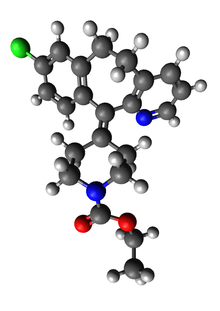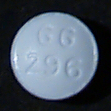Loratadine
 | |
 | |
| Clinical data | |
|---|---|
| Trade names | Claritin, Claratyne, others |
| AHFS/Drugs.com | Monograph |
| MedlinePlus | a697038 |
| Pregnancy category |
|
| Routes of administration | oral |
| ATC code | |
| Legal status | |
| Legal status |
|
| Pharmacokinetic data | |
| Bioavailability | almost 100% |
| Protein binding | 97–99% |
| Metabolism | Hepatic (CYP2D6- and 3A4-mediated) |
| Elimination half-life | 8 hours, active metabolite desloratadine 27 hours |
| Excretion | 40% as conjugated metabolites into urine Similar amount into the feces |
| Identifiers | |
| |
| CAS Number | |
| PubChem CID | |
| IUPHAR/BPS | |
| DrugBank | |
| ChemSpider | |
| UNII | |
| KEGG | |
| ChEMBL | |
| CompTox Dashboard (EPA) | |
| ECHA InfoCard | 100.120.122 |
| Chemical and physical data | |
| Formula | C22H23ClN2O2 |
| Molar mass | 382.88 g/mol g·mol−1 |
| 3D model (JSmol) | |
| |
| |
| | |
Loratadine is a second-generation peripheral histamine H1-receptor blocker used to treat allergies.[2][3] In structure, it is closely related to tricyclic antidepressants, such as imipramine, and is distantly related to the atypical antipsychotic quetiapine.[4]
Loratadine was discovered in 1981 and came to market in 1993.[5] It is on the World Health Organization's Model List of Essential Medicines, the most important medications needed in a basic health system.[6] It is available as a generic drug and is marketed for its nonsedating properties. There is a version combined with pseudoephedrine, a decongestant; known as pseudoephedrine/loratadine.
Medical uses
Loratadine is indicated for the symptomatic relief of allergy such as hay fever (allergic rhinitis), urticaria (hives), chronic idiopathic urticaria,[7] and other skin allergies.[8] For allergic rhinitis (hay fever), loratadine is effective for both nasal and eye symptoms: sneezing, runny nose, itchy or burning eyes.
Similarly to cetirizine, loratadine attenuates the itching associated with Kimura's disease.[9]
Forms

The drug is available in many different forms, such as: tablets, oral suspension, and syrup,[8] and in combination with pseudoephedrine.[10] Also available are quick-dissolving tablets, which are marketed as being faster to get into one's circulatory system, but require special handling to avoid degrading in the package.
Contraindications
Patients with severe hepatic (liver) disorders may need to start with a lower dose. No dose adaptation is necessary for elderly or renally (kidney) impaired patients.[2][8]
Loratadine is usually compatible with breast-feeding (classified category L-2 by the American Academy of Pediatrics).[11] In the U.S., it is classified as category B in pregnancy, meaning animal reproduction studies have failed to demonstrate a risk to the fetus but no adequate and well-controlled studies in pregnant women have been conducted.[12]
Adverse effects
As a "nonsedating" antihistamine, loratadine causes less (but still significant, in some cases) sedation and psychomotor retardation than the older antihistamines because it penetrates the blood/brain barrier to a smaller extent.[13]
Other possible side effects include headache and antimuscarinic effects such as urinary retention, dry mouth, blurred vision, and gastrointestinal disturbances.[2][8]
Interactions
Substances that act as inhibitors of the CYP3A4 enzyme such as ketoconazole, erythromycin, cimetidine, and furanocoumarin derivatives (found in grapefruit) lead to increased plasma levels of loratadine. This had clinically significant effects in controlled trials of higher-than-usual doses of loratadine (20 mg).[citation needed]
Antihistamines should be discontinued about 48 hr prior to skin allergy tests, since these drugs may prevent or diminish otherwise-positive reactions to dermal activity indicators.
Mechanism of action
Loratadine is a tricyclic antihistamine, which acts as a selective inverse agonist of peripheral histamine H1-receptors.[2][14] The inverse agonist potency of 2nd generation histamine antagonists is desloratadine > cetirizine > loratadine > fexofenadine.[14]
Pharmacokinetics
Loratadine is given orally, is well absorbed from the gastrointestinal tract, and has rapid first-pass hepatic metabolism; it is metabolized by isoenzymes of the cytochrome P450 system, including CYP3A4, CYP2D6, and, to a lesser extent, several others.[15][16] Loratadine is almost totally (97–99%) bound to plasma proteins. Its metabolite desloratadine, which is largely responsible for the antihistaminergic effects, binds to plasma proteins by 73–76%.[8]
Loratadine's peak effect occurs after one to two hours, and its biological half-life is on average 8 hours (range 3 to 20 hours) with desloratadine's half-life being 27 hours (range 9 to 92 hours), accounting for its long-lasting effect.[17] About 40% is excreted as conjugated metabolites into the urine, and a similar amount is excreted into the feces. Traces of unmetabolised loratadine can be found in the urine.[8]
History
Schering-Plough developed loratadine as part of a quest for a potential blockbuster drug: a nonsedating antihistamine. However, by the time Schering submitted the drug to the U.S. Food and Drug Administration (FDA) for approval, the agency had already approved a competitor's nonsedating antihistamine, terfenadine (trade name Seldane), and, therefore, put loratadine on a lower priority.[18]
Loratadine was approved by the FDA in 1993.[18] The drug continued to be available only by prescription in the U.S. until it went off patent in 2002.[19] It was then subsequently approved for over-the-counter sales. Once it became an unpatented over-the-counter drug, the price dropped significantly.
Schering also developed desloratadine (Clarinex), which is an active metabolite of loratadine.
Availability
Loratadine is available under many brand names and dosage forms worldwide.[20]
Loratadine is marketed by Bayer (formerly Schering-Plough, later Merck & Co.) under several trade names (e.g., Claritin, and Claratyne) and also by Shionogi in Japan. It is manufactured by Pfizer[21] among others.
In 1998, in an unprecedented action, the American insurance company Anthem petitioned the FDA to allow loratadine and two other antihistamines to be made available over the counter (OTC) while it was still under patent; the FDA granted the request, which was not binding on manufacturers.[22] In the US, Schering-Plough made loratadine available OTC in 2002.[22] Loratadine is currently available in many countries OTC.[23] Brand names include Claritin, Claratyne, Lorel (in Pakistan),[24][25] others.
See also
- Benzocycloheptenes
- Desloratadine 2° Amine
- Azatadine (Loratidine minus chlorine atom)
References
- ^ "FDA-sourced list of all drugs with black box warnings (Use Download Full Results and View Query links.)". nctr-crs.fda.gov. FDA. Retrieved 22 Oct 2023.
- ^ a b c d Mutschler, Ernst; Gerd Geisslinger; Heyo K. Kroemer; Monika Schäfer-Korting (2001). Arzneimittelwirkungen (in German) (8 ed.). Stuttgart: Wissenschaftliche Verlagsgesellschaft. pp. 456–461. ISBN 3-8047-1763-2.
- ^ Holdcroft, C. (1993). "Terfenadine, astemizole and loratadine: Second generation antihistamines". The Nurse practitioner. 18 (11): 13–14. doi:10.1097/00006205-199311000-00005. PMID 8278087.
- ^ Kay GG, Harris AG (July 1999). "Loratadine: a nonsedating antihistamine. Review of its effects on cognition, psychomotor performance, mood and sedation". Clinical and Experimental Allergy. 29 Suppl 3: 147–50. doi:10.1046/j.1365-2222.1999.0290s3147.x. PMID 10444229.
- ^ Corey, E.J. (2012). "Loratadine". Molecules and Medicine. John Wiley & Sons. ISBN 9781118361733.
- ^ "WHO Model List of EssentialMedicines" (PDF). World Health Organization. October 2013. Retrieved 22 April 2014.
- ^ Pons-Guiraud, A; Nekam, K; Lahovsky, J; Costa, A; Piacentini, A (2006). "Emedastine difumarate versus loratadine in chronic idiopathic urticaria: A randomized, double-blind, controlled European multicentre clinical trial". European journal of dermatology : EJD. 16 (6): 649–54. PMID 17229605.
- ^ a b c d e f Jasek, W, ed. (2007). Austria-Codex (in German). Vol. 1 (2007/2008 ed.). Vienna: Österreichischer Apothekerverlag. pp. 1768–71. ISBN 978-3-85200-181-4.
- ^ Ueda, T; Arai, S; Amoh, Y; Katsuoka, K (2011). "Kimura's disease treated with suplatast tosilate and loratadine". European journal of dermatology : EJD. 21 (6): 1020–1. doi:10.1684/ejd.2011.1539 (inactive 2015-11-29). PMID 21914581.
{{cite journal}}: CS1 maint: DOI inactive as of November 2015 (link) - ^ Jasek, W, ed. (2007). Austria-Codex (in German). Vol. 1 (2007/2008 ed.). Vienna: Österreichischer Apothekerverlag. pp. 1731–34. ISBN 978-3-85200-181-4.
- ^ Committee on Drugs (1 September 2001). "Transfer of drugs and other chemicals into human milk". Pediatrics. 108 (3): 776–89. PMID 11533352.
- ^ See, Sharon (November 15, 2003). "Desloratadine for Allergic Rhinitis". American Family Physician.
- ^ Kristi Monson, PharmD. "Claritin and Alcohol". emedtv.com.
- ^ a b Devillier P, Roche N, Faisy C. Clinical pharmacokinetics and pharmacodynamics of desloratadine, fexofenadine and levocetirizine : a comparative review. Clin Pharmacokinet. 2008;47(4):217-30. PMID 18336052
- ^ Nelson, Wendel L. (2002). "Antihistamines and related antiallergic and antiulcer agents". Foye's principles of medicinal chemistry. Hagerstown, MD: Lippincott Williams & Wilkins. p. 805. ISBN 0-683-30737-1.
{{cite book}}: Unknown parameter|editors=ignored (|editor=suggested) (help) - ^ Ghosal A, Gupta S, Ramanathan R, et al. (August 2009). "Metabolism of loratadine and further characterization of its in vitro metabolites". Drug Metab Lett. 3 (3): 162–70. doi:10.2174/187231209789352067. PMID 19702548.
- ^ Affrime, M; Gupta, S; Banfield, C; Cohen, A (2002). "A pharmacokinetic profile of desloratadine in healthy adults, including elderly". Clinical pharmacokinetics. 41 Suppl 1: 13–9. doi:10.2165/00003088-200241001-00003. PMID 12169042.
- ^ a b Hall, Stephen S. (2001-03-11). "The Claritin Effect; Prescription for Profit". The New York Times. Retrieved 2010-06-28.
- ^ "Schering-Plough Loses Patent Lawsuit Over Claritin, Opening Door For Cheaper Generic Versions". PRNewswire. Leiner Health Products. 2003-08-05. Retrieved 2016-06-26.
- ^ drugs.com Loratadine at drugs.com international listings Page accessed April 11, 2015]
- ^ "Pfizer Prescription Products". Pfizer Inc. Retrieved March 9, 2010.
- ^ a b Cohen JP et al. Switching prescription drugs to over the counter. BMJ. 2005 Jan 1;330(7481):39-41. PMID 15626806 PMC 539854
- ^ Association of the European Self-Medication Industry Database. Loratadine OTC regulation Page accessed April 11, 2015
- ^ http://www.standpharm.com/index.php/component/content/category/11-demo-articles
- ^ https://sehat.com.pk/products/Lorel-Tab-10mg-1x10's.html
External links
- Loratadine—MedlinePlus Drug Information, U.S. National Library of Medicine, National Institutes of Health
- Claritin (loratadine) drug description—RxList (Internet Drug Index)
- U.S. National Library of Medicine: Drug Information Portal – Loratadine
- Claritin.ph—Claritin Philippines Website
